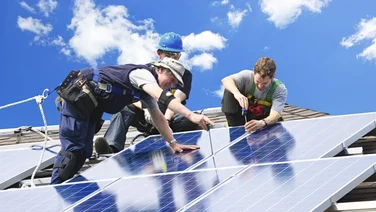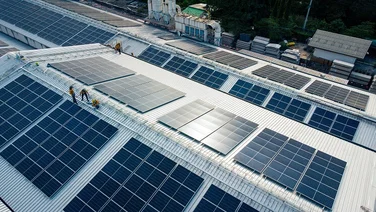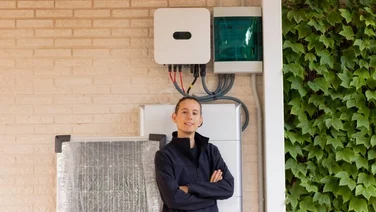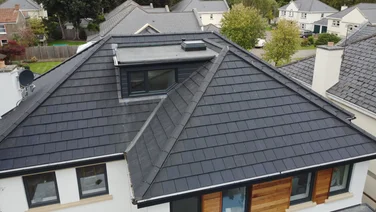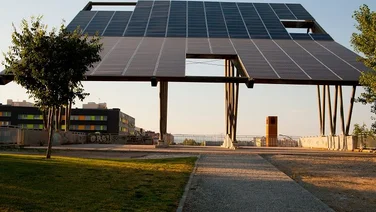- Generate free, green electricity
- Reduce your electricity bill by up to 64%
- Get paid for what you don’t use
With the cost of solar panels dropping, homes all over Wales are going solar. According to the MCS, around 100,000 households in Wales now have solar panels, meaning over 7.5% of Welsh households are cutting their electricity bills with renewable energy from the sun. In fact, Wales has the highest uptake of renewables per household in the UK.
And the demand for them is only growing. The Welsh government, for example, is adding solar panels to many public buildings to increase community-owned renewable energy in the region.
In this article, we will explain everything you need to know about solar panels in Wales, including their efficiency, costs, and government support schemes, like Nest, a scheme offering advice and support to Welsh residents. So, if you want to get on the solar bandwagon in Wales, youve come to the right place.
If youre ready to start looking for solar panels, we can help you compare solar panel prices. Enter a few details, and our trusted suppliers will contact you for free quotes.

Two homes with solar panels in Holyhead, on the Isle of Anglesey
Is it worth getting solar panels in Wales?
Solar panels in Wales are worth it because Wales gets more sunshine than the UK average. Of course, the systems efficiency may vary with the direction the panels face, topography of the area and the time of the year, but a typical 3.5 kW solar panel system in Wales will generate 2,800 kWh, above average.
The average payback time for a solar system is less than 141-15 years, which beats the UK average of 15.66 years. This makes solar panel financing worth it.
Factoring in your grid savings and the excess electricity you can sell via the Smart Export Guarantee (SEG), a three-bedroom home in Wales will, on average, save £477.02 per year cutting more than 70% off your electricity bills. You can also reduce carbon emissions by around 0.5 tonnes annually.
Solar panels may also help increase a propertys attractiveness, with 69% of people telling our latest National Home Energy Survey they were likely to buy or rent a property with solar panels.
Do solar panels work in Welsh weather?
Solar panels can work well in Wales, as the country receives more sunshine than the UK average.
Of course, the systems efficiency may vary with the direction the panels face and the time of the year.
Even on the sunniest days, your solar panels must be installed in the right place for maximum efficiency. South-facing solar panels will be more effective yearly than north-facing installations simply because theyll receive more sun.
Wales tends to get more sunshine than the UK average, though less than the England average.
Pembrokeshire, which is the sunniest part of Wales, typically receives more than 1,700 hours of sunshine annually. The mountainous areas are the least sunny, receiving less than 1,200 hours a year.
To put that into perspective, the Shetland Islands tend to receive 1,100 hours a year, while the Channel Islands tend to receive around 1,900 hours of sunshine a year. On average, May is when Wales tends to get the most sunshine in any given year, with December receiving the least.
How much do solar panels cost in Wales?
Solar panels cost £7,138 on average in Wales for a 3.5 kW solar panel system, including installation.
| House size | No. of panels needed | Cost | Tonnes of CO2 saved / year | Savings / year | Years to break even |
|---|---|---|---|---|---|
1-2 bedrooms | 6 | £4,283 | 0.3 | £328 | 13.07 |
3 bedrooms | 10 | £7,138 | 0.5 | £546 | 13.07 |
4+ bedrooms | 14 | £9,993 | 0.7 | £765 | 13.07 |
Solar panels continue to fall in price, which is great news as 69% of people ranked cost as the most important factor when evaluating which low-carbon product to purchase.
Working out the total cost of solar panels in Wales depends on a few factors. These include:
- The size (in kW) of the system
- Installation costs
- The type of panels and installer you choose
Live in Wales and ready to buy solar panels?
Generate free, green electricity Reduce your electricity bill by up to 64% Get paid for what you don't use

How many people have solar panels in Wales?
According to the Microgeneration Certification Scheme (MCS), around 100,000 homes in Wales have solar panels, which is around 7.5% of households.
Anglesey, Ceredigion and Powys are the areas in Wales with the highest rate of solar panels. In Anglesey, 16.34% of homes have solar panels, which is the third highest rate of any area in the UK.
In 2021, 28% of Wales electricity was renewable, and the government aims for this figure to hit 70% by 2030.
Theres an appetite for green technology in Wales, as shown by the fact that the country was ranked the most climate-conscious part of the UK in our 2023 National Home Energy Survey.
What do solar panel owners in Wales think about their systems?
We asked solar panel owners in Wales what they thought about their solar systems, and whether they thought the technology was worth the investment. Jaime Holmes, from Translating Patents, spoke to us about his solar panel system:
What solar panels do you have?
We have 12 solar panels installed on a south-facing pitched roof 440W REA Power FUSION 2 ·REA-HD108N-440. Rea is an Australia-based company.
Each panel is installed with an Enphase microinverter (Enphase IQ8HC-72-M-INT · 380W).
Do you have battery storage?
We have the 10 kWh Alpha ESS SMILE-G3-B5 battery.
How happy are you with your solar panels and would you recommend them?
We are very happy with the solar panels and their performance.
Besides the fact that they are some of the most efficient panels currently on the market, their smaller dimensions than most other panels mean that we can make more efficient usage of our roof space. Other proposals we received would have only allowed 7 to 8 panels on our roof because of the larger dimensions of other (also less-efficient) solar panels.
The interest in solar panels sort of came out of nowhere in the spring of 2024 against the backdrop of the never-ending rise in energy costs in the UK.
Getting solar panels was our way of gaining some financial independence. The way we see it is that cash savings would be eaten away by inflation in any case, and that the money we would have to spend on energy bills over the next 10 years would also come to an amount comparable to that of the system installation cost.
In fact, we were given a projected cash-equivalent return on investment of 10.7% per annum. In my mind, that would give an investment in equities a run for its money.
The real benefit though is just an immediate drop in monthly bills, and that is where peoples focus should be, in our opinion, rather than on recuperating the installation cost. Paying approximately £150 less on energy each month is the real benefit. That could mean the difference between a holiday or not or paying for your childrens extracurricular activities each month. It also means were also shielded from further rises in energy prices.
One of the unexpected benefits is that of the battery storage. Certain energy tariffs allow one to enjoy a higher export rate during peak grid times. Having battery storage means that a household can even save money during the winter or on dull days when solar panel performance is relatively low. This is done by charging the battery at night during off-peak times (at a lower unit price) and selling back to the grid during peak times i.e. playing on the difference in the low import unit price and the higher export unit price.
Weve calculated (and also experienced) that this alone can mean a 40% reduction in electricity energy costs. Our only regret with our solar panel system is that we did not opt for larger battery storage. Perhaps 15-20 kWh battery storage would have been preferable.
The solar panel system has exceeded our expectations. We are now confident that the energy export during the sunnier half of the year will offset most of our gas usage during the year (including that for heating in the winter). Our monthly energy direct debit is now only £10 and may drop to zero in the coming months.
The proposal for our solar panel system came with projections for energy production. For June (the peak generation month of the year), we were projected to generate an average of 22 kWh daily. The projections for March and April were 13.5 kWh and 18.1 kWh, respectively.
Our best day so far has been 35 kWh, and that was in April! This is approximately 3x our typical energy usage.
Compare the above projections with the actual averages of 19.1 kWh of energy generated per day during March 2025 and 25.46 kWh generated per day during April 2025.
Let it suffice to say that we are more than happy with our solar panel system.
Where do you want to install solar panels?
Get startedWhen do you break even on solar panels in Wales?
The average home will break even on solar panels in Wales after 13.88 years.
This compares favourably to the UK average, which is 15.66 years. If you spend more time at home or work from home, your payback period could be even shorter, between 6 and 10 years (depending on energy use).
However, such estimates assume that you get a big enough solar panel system to provide enough electricity to power half of your home’s needs for instance, a 3.5 kW array for the average three-bedroom house.
You can then sell the rest of your solar energy back to the grid, typically cutting your electricity bills by more than 70%.
What maintenance is needed for solar panels?
Solar panels should be cleaned with water every five years and professionally serviced every 5 – 10 years. For a comprehensive breakdown of how to maintain solar panels, check out our Complete Guide to Solar Panel Maintenance.
How much space is needed for solar panels?
Most residential solar panels are about 5.5ft long and 3.5ft wide, which means you’ll need about 18 sq ft per solar panel. A standard residential solar panel system requires 100-250 square feet of roof space per kW of installed capacity. A typical 5kW system would need 500-1,250 square feet.
What grants are there for solar panels in Wales?
The UK government offers a few different options for grants, rebates and schemes that can help reduce the cost of solar panels in Wales. These are detailed below.
ECO4
ECO4 was established to support low-income households that are unable to upgrade their homes and heating systems. The ‘4’ comes from the fact that ECO4 is the fourth and final stage of the scheme.
You can get up to £10,000 towards energy-saving initiatives if your home qualifies, including solar panel systems with ECO4.
To qualify, you’ll need to meet specific criteria including:
- A household income of up to £34,500 per year (for larger families of 4 or more children). If you are a single parent with one child, you’ll qualify for £19,900.
- Being referred by your energy provider, local authority, or doctor
- Receiving certain benefits
To apply to the ECO4 scheme, all you need to do is get in touch with one of the energy suppliers that are offering it.
Youll then be invited to a telephone assessment, which involves answering questions about your income, whether you receive benefits and your propertys energy efficiency rating.
The installer will then arrange a date to visit your home and confirm whether it suits the grant.
Additionally, your home must be insulated to a certain level before you can receive solar panels, which might mean you can also get insulation provided through the scheme.
There’s also LA Flex, which is a part of ECO4 and helps local councils expand the eligibility for the scheme for those who might not meet the benefit criteria.
Nest
The Welsh government introduced the Nest scheme to offer free, impartial advice on making your home warmer and more energy efficient and, if you’re eligible, free energy efficiency improvements, including solar panels.
The Nest Scheme includes advice and support on saving energy and money in your home and funded home energy improvements.
Every resident in Wales is eligible for advice and support, but you must meet certain conditions to qualify for funding. These include:
- Your home must be privately owned or rented
- Your home has poor energy efficiency and is expensive to heat
- You or someone you live with receives a means-tested benefit OR has a chronic respiratory, circulatory, or mental health condition and an income below certain thresholds
If you think you meet the eligibility criteria, call Nest on 0808 808 2244 or request a callback using their online form.
An advisor from Nest will ask you a few questions to see if you and your property qualify for any free home improvements. If youre successful with your application, an assessor will visit your home to see what energy efficiency improvements they can offer.
Like every country in the UK apart from Northern Ireland, Wales benefits from the SEG.
The Smart Export Guarantee
You can make money from solar panels via the Smart Export Guarantee (SEG). The SEG is a form of solar funding that allows you to make a small amount of money from feeding your spare electricity back into the grid.
The best rate available nationwide is 24p per kilowatt hour (kWh) from Octopus Energy. However, this does change over time, so be sure to shop around to get the best bang for your buck.
Licensed electricity suppliers (those with 150,000 customers or more) are required by law to offer an export tariff for people who choose to use the SEG.
VAT reduction
The UK government introduced 0% VAT on energy-saving materials, including solar panels, in April 2022, and this rate will last until 2027.
This should help encourage more households to adopt the technology and save on energy bills.
In 2022, the VAT on energy-efficient systems was reduced from 5% to 0%. This can reduce the cost of installing solar panels in Wales by up to £1000.
The 0% VAT reduction will last until 2027. This should help encourage more households to adopt the technology and save on energy bills.
Next steps
If you can afford solar panels, theyre worth getting. They allow you to generate your power while slashing your carbon footprint. Thats a win-win in our books!
But remember, the number of panels you need and the overall cost depend on the energy you consume and the number and size of panels installed.
You can start finding solar panels with our handy (and free) comparison tool. Fill in a few details, and our trusted suppliers will contact you with free quotes.


